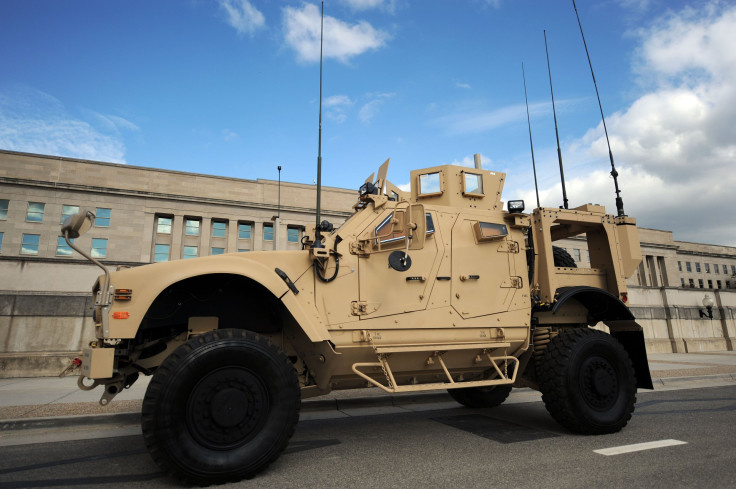The Pentagon Just Slammed This Contractor's Flagship Vehicle

The Pentagon's Humvee replacement has been deemed "not operationally suitable" due to a wide range of deficiencies, a setback for the $30 billion program and a fresh challenge for vehicle manufacturer Oshkosh (NYSE:OSK).
The first Oshkosh-made Joint Light Tactical Vehicles (JLTVs) were fielded at Fort Stewart in Georgia in mid-January, a major milestone for one of the Army's priority replacement programs. But according to an annual report prepared by the Pentagon's Director of Operational Test and Evaluation, those vehicles suffer from a range of issues in areas including "reliability, maintainability, training, manuals, crew situational awareness, and safety."
The vehicle will likely require more maintenance than the Humvee, the audit warns, with a greater reliance on contractors to perform that maintenance due to its "poor manuals, and the challenges with troubleshooting the vehicle." The close-combat version is "not operationally effective for use in combat and tactical missions" at this time, the audit warns, because the missile reload process "is slow and difficult for crews," and the JLTV provides poor visibility for crews.
The vehicle is also at a greater risk of being detected on the battlefield because of its larger size and greater noise signature, the report found.
Trade-offs, teething, and training
The report is a black eye for the JLTV, but some of the complaints are issues typical for a new program, and they can be addressed in later manufacturing batches. The vehicles have engine wiring issues and brake system faults that need to be redesigned, and in some cases, the doors would jam and prevent a quick exit from the vehicle.
Other issues are tied to design choices made by the Pentagon. The JLTV from the beginning was meant to improve upon the Humvee's shaky record in the Middle East, where it was susceptible to ambushes and improvised explosive devices. The response was to create a larger vehicle with better body armor and more high-tech electronics.
The armor and extra battery power for the electronics require a bigger, heavier vehicle with a more powerful, and louder, engine. The decreased visibility is another trade-off of loading the vehicle with more armor so it is better able to withstand an enemy attack. Much of the Pentagon's plan to address the identified shortcomings is classified, implying that the Army is willing to live with the issues and adjust tactics instead of demand wholesale changes to the design.
As Oshkosh gains experience manufacturing the vehicle and the military gains experience maintaining it, some of the issues should resolve themselves. Others are design trade-offs that the Pentagon recognized going into the procurement process. Importantly, the audit did conclude that the JLTV is "operationally effective" to be used in combat and tactical missions, so despite the issues, the government has concluded the vehicle is able to do what it is supposed to do.
This is still a win
Although perhaps best known as a maker of lifts and fire equipment, Oshkosh has built an impressive defense business. The JLTV might be under fire for now, but the military momentum should continue to grow for the foreseeable future.
Oshkosh's August 2015 victory over Lockheed Martin and a General Dynamics/AM General pairing to produce the JLTV was a big win in part due to the sheer volume of orders expected for the versatile vehicle.
In the years to come, the Pentagon could purchase up to 60,000 JLTVs at a total procurement cost of more than $30 billion. That number should grow once foreign sales are factored in, with the United Kingdom, Slovenia, and Lithuania all early potential buyers and a slew of other U.S. allies expected to come on board over time. To get an idea of the potential market size, today there are more than 240,000 Humvees in service in 60 countries.
Defense is expected to account for about one-quarter of Oshkosh's projected $8.05 billion to $8.25 billion in fiscal 2019 revenue. While defense margins, at 9.75%, trail access equipment and fire and emergency, the defense business should become more profitable as the vehicles move to full production. Defense is also the most predictable of Oshkosh's segments, with a backlog of $3.2 billion that is nearly double the backlog of any other unit and a delivery schedule stretching well into the next decade.
Oshkosh, even after a nice share-price jump late last year, still trades at an affordable 11 times earnings. Given its ties to the construction cycle, a discount to more defense-focused General Dynamics' 15 times multiple makes sense, but the market is underestimating the ability of the defense business to pad a downturn in the construction or industrial segments.
Thanks to defense, Oshkosh is a winner even in a slow-growth industrial world.
This article originally appeared in The Motley Fool.
Lou Whiteman has no position in any of the stocks mentioned. The Motley Fool has no position in any of the stocks mentioned. The Motley Fool has a disclosure policy.





















